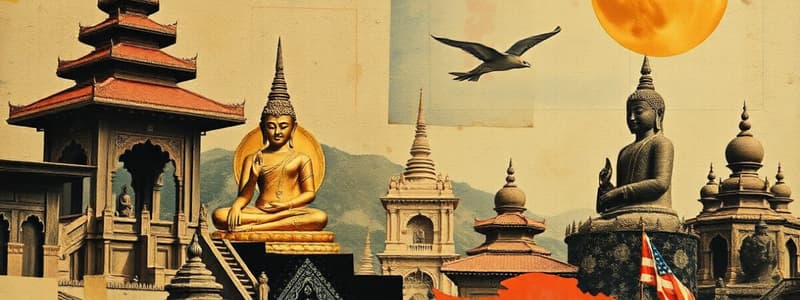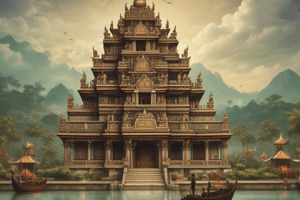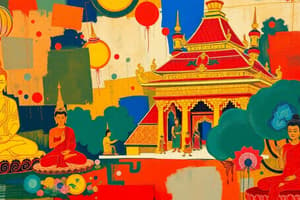Podcast
Questions and Answers
Which of the following best describes the political structure of the Champa kingdoms?
Which of the following best describes the political structure of the Champa kingdoms?
- A collection of independent polities. (correct)
- A theocracy ruled by Hindu priests.
- A tributary state of the Khmer Empire.
- A unified empire with a single ruler.
What was a significant agricultural practice adopted by the Champa kingdoms?
What was a significant agricultural practice adopted by the Champa kingdoms?
- Cultivation of drought-resistant rice. (correct)
- Intensive wheat cultivation using irrigation systems.
- Large-scale cash crop farming of tea and coffee.
- Extensive rice paddy farming in mountainous regions.
What is the most significant legacy of the Khmer Empire?
What is the most significant legacy of the Khmer Empire?
- The Angkor complex, a major urban center. (correct)
- Its sophisticated system of irrigation canals.
- Its vast naval power that controlled the Indian Ocean.
- The development of a standardized written language.
Satellite imaging revealed what about the city of Angkor during its peak?
Satellite imaging revealed what about the city of Angkor during its peak?
What was a primary reason for Hindu rulers in Southeast Asia to embrace the caste system?
What was a primary reason for Hindu rulers in Southeast Asia to embrace the caste system?
Besides the caste system, what other aspect of Hinduism appealed to the Southeast Asian ruling classes?
Besides the caste system, what other aspect of Hinduism appealed to the Southeast Asian ruling classes?
Compared to Hinduism, how was Buddhism generally perceived within Southeast Asia?
Compared to Hinduism, how was Buddhism generally perceived within Southeast Asia?
What was the primary significance of Srivijaya in Southeast Asia?
What was the primary significance of Srivijaya in Southeast Asia?
Which of these statements best describes the influence of Srivijaya in Southeast Asia?
Which of these statements best describes the influence of Srivijaya in Southeast Asia?
Which empire is primarily responsible for the fall of Srivijaya?
Which empire is primarily responsible for the fall of Srivijaya?
What is considered to be a major accomplishment of the Majapahit Empire?
What is considered to be a major accomplishment of the Majapahit Empire?
What was the primary way in which Islam spread to the Majapahit Empire?
What was the primary way in which Islam spread to the Majapahit Empire?
What was a major factor in the rise of trade city-states around the 11th and 12th centuries?
What was a major factor in the rise of trade city-states around the 11th and 12th centuries?
How did the wealth of Venice and Malacca differ from the wealth of the Swahili city-states or Timbuktu?
How did the wealth of Venice and Malacca differ from the wealth of the Swahili city-states or Timbuktu?
What was the primary function of Kashgar during its 2,000-year history?
What was the primary function of Kashgar during its 2,000-year history?
Flashcards
Champa Kingdoms
Champa Kingdoms
A collection of independent Cham polities that existed along the coast of central and southern Vietnam from the 2nd to 19th centuries CE.
Khmer Empire
Khmer Empire
A Hindu-Buddhist empire that existed in Southeast Asia from 802 to 1431 CE. Known for its grand city of Angkor.
Angkor
Angkor
A major capital city of the Khmer Empire in present-day Cambodia, known for its impressive architecture and urban scale.
Srivijaya Empire
Srivijaya Empire
Signup and view all the flashcards
Majapahit Empire
Majapahit Empire
Signup and view all the flashcards
Malacca
Malacca
Signup and view all the flashcards
Timbuktu
Timbuktu
Signup and view all the flashcards
Swahili City-States
Swahili City-States
Signup and view all the flashcards
Kashgar
Kashgar
Signup and view all the flashcards
Samarkand
Samarkand
Signup and view all the flashcards
Spread of Hinduism in Southeast Asia
Spread of Hinduism in Southeast Asia
Signup and view all the flashcards
Spread of Buddhism in Southeast Asia
Spread of Buddhism in Southeast Asia
Signup and view all the flashcards
Venetian Maritime Power
Venetian Maritime Power
Signup and view all the flashcards
Major Afro-Eurasian Trade Networks
Major Afro-Eurasian Trade Networks
Signup and view all the flashcards
Study Notes
Empires of Southeast Asia and Trade Cities
- Champa kingdoms existed in central and southern Vietnam from the 2nd to 19th centuries CE
- It adopted Hinduism and drought-resistant rice cultivation
- The Champa kingdom was annexed by the Vietnamese Emperor Minh Mang in 1832 CE
- The Khmer Empire, also known as the Angkor Empire, existed in Southeast Asia from 802 to 1431 CE
- Angkor, in present-day Cambodia, was the Khmer Empire's major capital and a significant urban center during the 11th to 13th centuries
- Angkor was the largest pre-industrial urban center in the world during its peak
Religion in Southeast Asia
- Hinduism originated in India and spread easily to Southeast Asian kingdoms
- Hinduism consolidated state systems by reinforcing the caste system at the top of the hierarchy
- Southeast Asian rulers admired Hindu deities, particularly Shiva and Vishnu
- Rulers emulated Indian civilization and culture, leading to grand architectural works like Angkor Wat
- Buddhism emerged at the same time as Hinduism, becoming more popular among lower classes due to its egalitarian outlook
Srivijaya and Majapahit Empire
- Srivijaya was a powerful maritime Indonesian kingdom based on Sumatra
- It heavily influenced Southeast Asia and served as a significant center for Buddhism from the 8th to the 12th century
- Srivijaya was the first major unified kingdom to dominate the Indonesian archipelago
- The Majapahit Empire succeeded Srivijaya and was a maritime empire in Southeast Asia from 1290 to 1500 CE
- Majapahit was known for repelling the Mongols under Kublai Khan in the 13th century
- Islam gradually replaced Buddhism as the majority religion in the region
Trade City-States: Europe & Southeast Asia
- Trade expanded in the Indian Ocean during the 11th and 12th centuries, leading to the growth of city-states
- Venice controlled Mediterranean trade around 1000 CE, becoming wealthy through trade with the East and the Byzantine Empire
- Venice also became powerful financial lenders, establishing the world's first banks
- Malacca was the main city-state of the Buddhist Srivijaya civilization (670-1025)
- Malacca was strategically located at a crucial trading chokepoint
- Malacca's naval power and control of trade routes were similar to Venice's
Major Afro-Eurasian Trade Networks
- Major trade routes connected different parts of Afro-Eurasia in the 1300s CE
- These routes included Buddhist, Christian, and Islamic trade sectors
Trade City-States: West & East Africa
- Timbuktu emerged as a major city-state in West Africa, benefiting from the Trans-Saharan trade routes (domestication of camels) using caravans
- Timbuktu exported copper, salt, gold, slaves, and manufactured goods
- Swahili city-states in East Africa grew in the Muslim world's trade networks
- These East African city-states exported gold and ivory, developing into royal cities
Trade City-States: Central Asia
- Kashgar in Central Asia served as a significant oasis trading post on the Silk Road for over 2000 years
- It was a key checkpoint for trade between China, the Middle East and Europe
- Samarkand (south-eastern Uzbekistan) was another important city in Central Asia, and one of the oldest continuously inhabited cities, playing a significant role in the Silk Road trade routes and under various empires
Studying That Suits You
Use AI to generate personalized quizzes and flashcards to suit your learning preferences.





